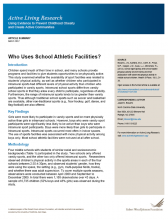We are pleased to announce an exciting new alliance between Active Living Research and GP RED to co-host and coordinate...
Who Uses School Athletic Facilities?
The Challenge: Childhood obesity and overweight in the U.S. remain a significant public health concern. Although regular physical activity provides numerous physiological and mental health benefits for children and adolescents, recent data suggest that they are not getting recommended levels of physical activity. Individual behaviors, community structure, lifestyle, and the built environment are primary contributing factors to this shortfall.
Make an impact: Because children spend much of their time in school, schools can play a significant part in increasing children’s physical activity by providing programs and facilities to give students opportunities to be physically active.
What the findings are about: This study examined whether the availability of sport facilities was related to students’ physical activity, as well as whether children who participated in intramural sports had different levels of physical activity than children who participated in varsity sports. Intramural school sports differ from varsity school sports in that they allow every child to participate, regardless of ability. Furthermore, the range of intramural sports tends to be greater than varsity sports. Thus although traditional school sports such as soccer and basketball are available, other non-traditional sports (e.g., floor hockey, golf, dance, and flag football) are also offered.
- Girls were more likely to participate in varsity sports; and girls in varsity sports were more physically active than girls in intramural sports.
- However, boys who were varsity sport participants were significantly less likely to be active than boys who were intramural sport participants.
- Boys were more likely than girls to participate in intramural sports.
- Offering single-sex intramural sports programs may improve girls’ levels of activity.
- School sports facilities were often empty or not used much after school. Joint use of school facilities with community partners or local government agencies (such as public departments of parks and recreation) could result in greater use of facilities, by ensuring that they are available for children outside of school hours.
Read the full article: School Sport Policy and School-based Physical Activity Environments and their Association with Observed Physical Activity in Middle School Children
- DOWNLOAD "Who Uses School Athletic Facilities?" PDF (0.04 MB) Article Summary
Related Tools & Resources
STAY UP TO DATE
RECENTLY ADDED TOOLS & RESOURCES
MOVE! A BLOG ABOUT ACTIVE LIVING
The "Active Living Conference" aims to break down research and practice silos and...








